Table of contents
Do you know what the main building foods are?
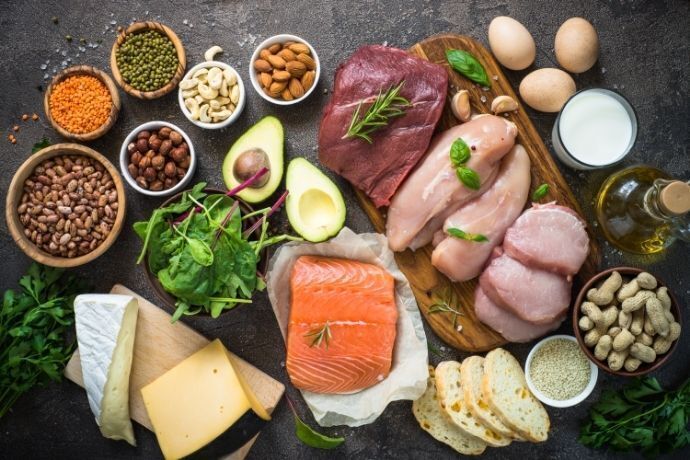
When we talk about building foods, many people don't know what they're talking about, but it's a type of food that has been on our tables for a long time: foods that provide our bodies with protein.
They are classified into two groups according to their origin: vegetable protein and animal protein. The most popular sources are meat, pulses, oilseeds, eggs, seeds, tofu, milk and dairy products.
Although they are extremely important for the proper functioning of the body, building foods must be combined with the other groups in order to have a balanced diet. Find out all about them below.
Understanding more about building foods
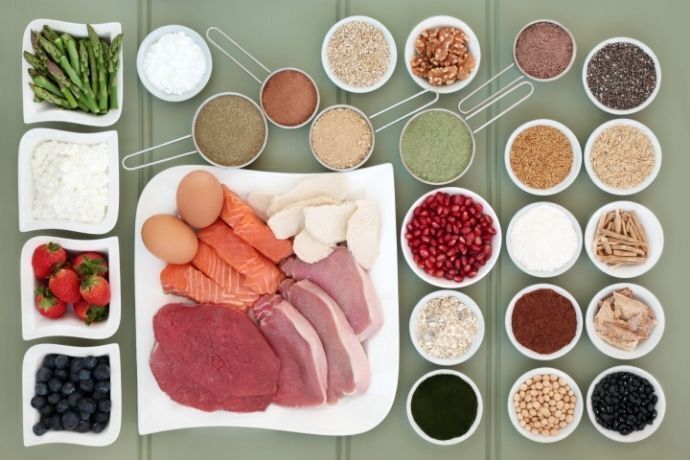
Building foods are able to promote the feeling of satiety, as they stimulate an increase in serotonin levels. It is therefore well worth investing in protein-rich meals. Check them out.
What are building foods?
Responsible for the construction and formation of the body, building foods are fundamental for the proper functioning of the metabolism. Their function is structural, as they act in the creation, development and maintenance of all the tissues in our body.
These foods help form muscles, blood components, bones, hair, nails and all organs, including the skin. They also boost our immunity, as they help defend the body against diseases.
Building foods are especially essential during childhood and adolescence, as they help the body grow and mature. They are also very important for maintaining a good amount of muscle mass as we get older.
Food groups and their functions
It's very important to eat all the food groups to ensure a routine of healthy habits, because a well-colored and diversified plate offers practically all the nutrients the body needs in a day.
Food is generally divided into 4 main categories: carbohydrates, proteins, lipids and vitamins. Find out all about the characteristics and functions of each of them below.
Carbohydrates: energy function
The first group of foods is carbohydrates, which are responsible for providing the body with energy. They are also sources of fiber and vitamins, such as B-complex and E vitamins.
The most popular representatives of this category are: bread, cake, pasta, corn, wheat, oats, linseed, granola, rice, pasta in general, potatoes, beet, bananas, cassava and sugar.
It's worth noting that the consumption of this group should be moderate, especially if you're sedentary. However, when it comes to athletes, eating carbohydrates is an excellent strategy for providing quick energy before physical activity, as the absorption of glucose is immediate.
Proteins: building function
Proteins are responsible for building new tissues in the body, acting mainly in the formation of muscle mass and structural cells in the body, as well as healing wounds.
Meat, eggs, quinoa and tofu are some of the representatives of this food group, as they are rich in protein and B vitamins and thus help maintain cell and bone health.
In addition, these nutrients provide the ideal conditions for the body's growth during childhood and adolescence, and are also extremely important during ageing.
Lipids: energy and building function
Lipids are an important source of energy for the body and are also present in many hormones. They are responsible for transporting the B vitamins and also have moisturizing properties.
However, because they are high-calorie foods and there is a possibility that they will increase bad cholesterol (LDL), they need to be consumed in moderation. Although their intake needs to be controlled, lipids are essential for professional athletes. This is because, after carbohydrates, they are the main source of energy during physical activity.
Vitamins: regulatory function
Vitamins belong to the group of regulators and are essential for the functioning of the body. As these nutrients are not produced by our body, the recommendation is to consume three portions a day.
Vitamins are responsible for regulating hormones and enzymes, so they play an active role in maintaining the performance of organs such as the heart and brain. They also play a role in muscle contraction and physiological balance.
Their main representatives are fruits, vegetables and greens, as they are rich in vitamins, minerals and fiber, thus contributing to the health of the whole body and being fundamental for strengthening immunity.
The importance of protein in the diet
Proteins are very important for maintaining the proper functioning of our body as a whole. Discover some of their actions:
- Gain muscle mass;
- Weight loss (accumulated fat);
- Baby formation during pregnancy;
- Promotes growth in childhood and adolescence;
- Prevents muscle loss as we get older;
- Strengthening immunity;
- Formation of blood cells and body tissues;
- Healing after wounds, burns and surgery;
- Formation of hormones, enzymes and secretions;
- Increased skin elasticity and firmness.
What are the main sources of protein?
High in protein, building foods can be divided into two large groups according to their origin, animal or vegetable. The main sources are therefore:
- Meat, fish and seafood;
- Eggs;
- Milk and its derivatives, such as yogurt and cheese;
- Legumes such as peanuts, beans, soybeans, lentils and chickpeas;
- Seeds such as quinoa, buckwheat, sesame, linseed, pumpkin seeds and rice;
- Oilseeds, such as cashews, almonds, hazelnuts, Brazil nuts and walnuts;
- Tofu.
Main building foods of animal origin
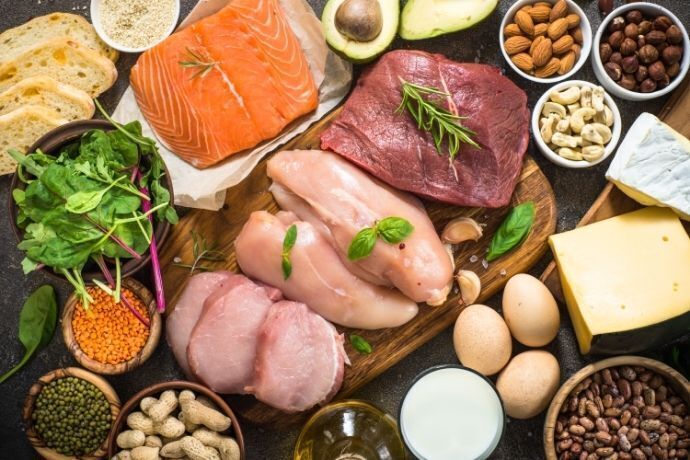
With their high nutritional value, animal-based building foods are classified as complete proteins, as they contain all the essential amino acids our bodies need. Find out what the main sources are below.
Chicken meat
One of the most consumed foods in the world, chicken is rich in protein and vitamin B6, making it an excellent ally for brain health, as studies show that niacin can protect against diseases that cause memory loss and cognitive disorders. It is therefore especially recommended for children and the elderly
Another positive point is that all parts of the bird can be used, as the giblets are full of nutrients. The liver, for example, contains a large amount of vitamin B12, which is essential for the creation of red blood cells.
However, you have to be careful how you consume it, as the meat should never be eaten undercooked. Chicken can therefore be sautéed, grilled, roasted or made into delicious preparations, such as the popular coxinha.
Beef
Rich in protein and other essential nutrients, beef helps maintain the health of the heart and nervous system, as it is a source of B vitamins, mineral salts, iron, zinc, phosphorus, potassium, magnesium and selenium.
As this meat provides all the essential amino acids for the body to function properly, it can be eaten boiled, braised, grilled, roasted or stewed. It is perfect for preparing stroganoff and barbecue, for example.
However, it's worth avoiding fried foods, because beef is high in saturated fat, which in excess increases the risk factors for cardiovascular disease. The tip is to choose lean cuts whenever possible.
Pork
Usually, when people talk about pork cuts, many turn up their noses. This is because pork has a reputation for being very heavy, yet it can provide a very light and healthy meal.
To give you an idea, pork loin is one of the foods with the highest protein content, approximately 50g in a 100g portion, with only 8g of fat. In addition, pork is a source of B vitamins, iron, selenium, zinc and potassium.
It's therefore worth investing in dishes with pork loin, ribs and steaks. They're delicious grilled, boiled and roasted, but, like chicken, they can't be undercooked.
Salmon, tuna and other fish
A source of good fats, fish have an anti-inflammatory effect and also prevent diseases, because they contain large amounts of phosphorus, iodine, calcium, riboflavin (vitamin B2) and thiamine (B1).
Salmon is rich in omega-3, a great ally for heart health. In fact, studies show that eating this fish reduces the chances of suffering a heart attack by up to 80%.
Also rich in omega-3, tuna is packed with nutrients, including B vitamins, iron and antioxidants, which help improve immunity and prevent anemia.
Very versatile, fish can be boiled, baked, fried or even raw as sashimi. However, it's worth remembering to watch out for bones.
Milk and dairy products
Dairy products are a source of protein, vitamin A and calcium, helping to maintain bone density and strengthen the immune system. However, whole milk is high in saturated fats, so it's best to opt for skimmed varieties.
As a dairy product, cheese contains basically the same nutrients. It is lower in calories than whole milk because it loses water during processing, but it is high in sodium. Therefore, consumption should be moderate.
Yogurts, on the other hand, are usually sweetened and have added colorings and chemical additives, so the tip is to look for the most natural and healthy version possible, skimmed and sugar-free.
Egg
It doesn't matter if the egg is chicken, quail, free-range or organic, they are all great sources of protein and this food is practically a natural multivitamin. It is rich in folate, minerals, riboflavin and vitamins A, D, E, K and B12.
For a long time, it was seen as a villain, as there was a belief that it increased cholesterol. However, studies have revealed that it is capable of lowering levels of bad cholesterol (LDL) and increasing good cholesterol (HDL).
As a highly digestible protein, it is perfect boiled, scrambled, as a poach, omelette and in other culinary preparations. The only recommendation is to avoid fried eggs, as they are more calorific and fatty.
Duck meat
Little consumed in Brazil, duck meat is extremely rich in protein. To give you an idea, a 100g portion of breast provides more than half of the daily requirement of this nutrient.
This bird is also a source of iron, selenium and vitamin B3. In 100g of meat, we find half the amount of vitamin B3 recommended for an adult.
Similar to chicken, but with a few peculiarities, duck is a good option to vary the menu. However, as it has a tougher meat, it must be prepared in a pressure cooker. In addition, the piece must be washed and pre-cooked in boiling water for 5 minutes.
Shrimp
Prawns contain excellent amounts of omega-3, protein, antioxidants, B vitamins and minerals such as zinc, potassium and iodine. Thanks to these nutrients, they are excellent for the nervous system, as they improve long-term thinking.
Therefore, this food should be part of your diet, but don't overdo it, because it is considered to be flammable, which means it can be toxic and cause inflammation when consumed in excess. Furthermore, it is not recommended for those who are recovering from surgery, as it can damage healing.
So the tip is to prepare several recipes, such as risotto, pie and bobó, so that you don't eat as much of the crustacean as if it were fried.
Seafood
With a huge amount of protein, seafood is rich in omega 3, calcium, zinc, iron, selenium and vitamins B12, D and E. It is also a source of 9 essential amino acids, making it a very complete food.
Versatile, the mollusc can be grilled, roasted or boiled. However, it does require some care when choosing it. You should buy the freshest ones, avoiding those that are unopened, and eat them the same day you buy them.
Consumption should be moderate because shellfish feed on waste, which can contain toxins and heavy metals. In addition, individuals with gout may suffer an increase in uric acid levels due to some components of shellfish.
Kefir
For those who don't know, kefir is a group of probiotic bacteria that produce a fermented drink. It is rich in enzymes, which aid digestion, and some nutrients, such as B vitamins, calcium, phosphorus and magnesium.
As it is usually made from animal or vegetable milk, it inherits many of its nutritional values, including protein. As a very versatile food, it can be eaten pure or in culinary preparations.
One tip is to eat it as a yoghurt, with fruit and honey. Other options are vitamins, salad dressings, cakes and quiches. However, it is worth noting that it loses some of its properties when heated.
Main building foods of plant origin
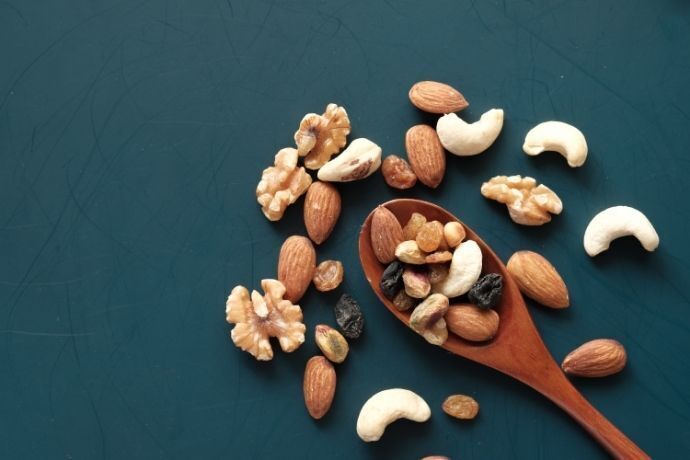
Constructive foods of plant origin are high in fiber and nutrients, as well as being lower in calories and giving a feeling of satiety. Therefore, it can be said that they are great for those seeking a healthy diet. Find out more below.
Soy
A great option for vegetarians and vegans, soya is rich in vegetable protein, a very important nutrient for the proper functioning of the body. With a powerful combination of vitamins and minerals, soya is able to prevent cardiovascular diseases and anemia.
Soya is a source of vitamins A and C, so it helps to make eyes, skin and hair much stronger and healthier. It also helps to improve the immune system. It can be eaten cooked, sautéed and in stews. It also comes in the form of textured protein (the famous soya meat), flour, soya milk, tofu and yoghurt.
Quinoa
Quinoa is a seed rich in vegetable protein and fibre and is excellent for giving the feeling of satiety, thus helping with weight loss. It also optimizes intestinal function and regulates blood sugar levels.
As a source of phenolic compounds such as quercetin, kaempferol and flavonoids, it has antioxidant and anti-inflammatory properties, strengthening immunity and preventing the development of heart disease.
With a very mild flavor, it's a great substitute for rice and an excellent accompaniment to meat and vegetables. It can also be used in sweet recipes, such as cakes and cookies. Another plus point is that quinoa can be eaten by celiacs or anyone who wants to remove gluten from their diet.
Seeds
With a wide range of health benefits, seeds bring fiber, antioxidant compounds, vitamins, minerals and vegetable proteins to your diet.
Flaxseed, for example, is considered the queen of satiety, as it takes up a lot of space in the stomach and slows down its emptying, making it a great ally for those trying to lose weight. It can be eaten pure, in juices, breads, yoghurts, stews and even in the form of oil or flour.
Sesame, on the other hand, is a favorite in Asian cuisine, and no wonder, as it is rich in iron, calcium, tryptophan and fiber. It is perfect for slowing down the early growth of gray hair and also helps to renew the protective barriers of the skin and teeth. This seed is often present in soups, ice cream, juices and recipes with fish.
Peas and lentils
Peas are rich in vegetable protein, vitamins and minerals and offer numerous health benefits. They are also a source of soluble and insoluble fiber, which is essential for the proper functioning of the intestinal tract.
Very versatile, they can be used in practically all savoury preparations. However, it's worth keeping an eye on canned versions, which can be high in sodium.
Lentils are another small food when compared to their enormous nutritional value. They are a source of minerals such as iron, manganese and potassium, as well as vitamins C and K. They are also a great friend of women's health.
This is because it reduces PMS thanks to the presence of lignans, substances that play a similar role to female hormones. Rich in protein, they help to replenish the blood lost during menstruation.
Tofu
With a protein content very close to that of meat, tofu is an excellent substitute. To give you an idea, 100g has 12% of this nutrient, while meat has between 16 and 20%. What's more, the biggest advantage is that it has no cholesterol or saturated fat.
Another positive point is that tofu contains a lot of isoflavone, a compound that regulates hormone production, combating PMS and menopause symptoms. As it is a fresh food with no preservatives, it only has a shelf life of 5 days, but can be frozen for up to 6 months.
Very versatile and with a neutral taste, it appears in a wide variety of dishes. It can be eaten cooked or sautéed, in miso soup (a typical Japanese soup), in pâtés, mayonnaises, puddings, mousses and even ice cream.
Beans
A favorite of Brazilian cuisine, beans are a super-powerful legume. With 14 types available, they are great for varying the menu: carioca, black, string, jalo, white, pink, fradinho, rajado, bolinha, azuki, purple, moyashi, green and red.
Perfect for daily consumption, it contains essential nutrients such as protein, iron, calcium, B vitamins, carbohydrates and fiber. In addition, its phytochemicals help fight diabetes and cardiovascular diseases.
Another highlight is its broth, which is rich in minerals, as it concentrates up to 73% of these nutrients. The most effective way to cook it is in a pressure cooker, as it is ready much faster and retains iron and zinc. It is also the protagonist of one of Brazil's most famous dishes, feijoada.
Chickpeas
Chickpeas are a source of various nutrients, including fiber and vitamins B, C, E and K, which together give the body more energy. They are also rich in minerals such as calcium, magnesium, phosphorus and potassium.
As well as being high in protein, it has an excellent combination of amino acids, such as tryptophan, which stimulates the production of serotonin. It is therefore very beneficial for combating early menopause, which occurs when the ovaries fail earlier than expected.
It is a typical legume in Middle Eastern dishes, such as pâtés, but can also appear cooked in salads or roasted as an appetizer.
Almonds and chestnuts
Part of the oleaginous fruit group along with hazelnuts, walnuts and Brazil nuts, almonds are considered a superfood because they are a source of protein, fiber and good fats, which improve heart, intestinal and brain health.
In addition, almonds are rich in calcium, magnesium and potassium, making them ideal for maintaining healthy bones and muscles, thus preventing diseases such as osteoporosis.
Brazil nuts and walnuts, on the other hand, have high levels of omegas 3 and 6, essential fatty acids for optimizing cognitive functions and strengthening the immune system. As a tasty and practical food, they are perfect for eating at any time of the day. They are present in salads, cereal bars, breads and cakes.
Spinach and broccoli
Rich in B-complex vitamins, A, C and K, spinach leaves are perfect for boosting the immune system. They also contain large amounts of vegetable protein, phosphorus, potassium and iron, making them a great ally in the fight against anemia.
Another highlight is the fiber, as spinach has twice as much as most of its green companions. It is ideal sautéed or steamed, in risottos, creams and fried as tempura.
Broccoli, on the other hand, is a source of fiber, protein, antioxidants, iron, potassium, calcium, magnesium and vitamins A, C, E and K. No wonder parents are always encouraging their children to eat this vegetable.
Very versatile, it is present in many recipes, such as pies, soufflés, pizzas, omelettes, lasagne and risottos. It also goes well with rice, meat and potatoes. However, if consumed in excess, it can block the absorption of iodine, affecting thyroid function. The ideal is a portion of 150g a day.
Apricot
One fruit that is not widely consumed in Brazil is the apricot, but it is very beneficial for health. It contains vegetable proteins, beta-carotene, a substance that strengthens immunity, and lycopene, a compound that prevents the proliferation of cancer cells and cardiovascular problems.
It is also a source of vitamin A, which is essential for eye health. It can be eaten in the form of jellies, juices, salads and sauces, as well as fresh. As it has a unique taste, it harmonizes perfectly with foods that sweeten our palate.
Other information about building foods
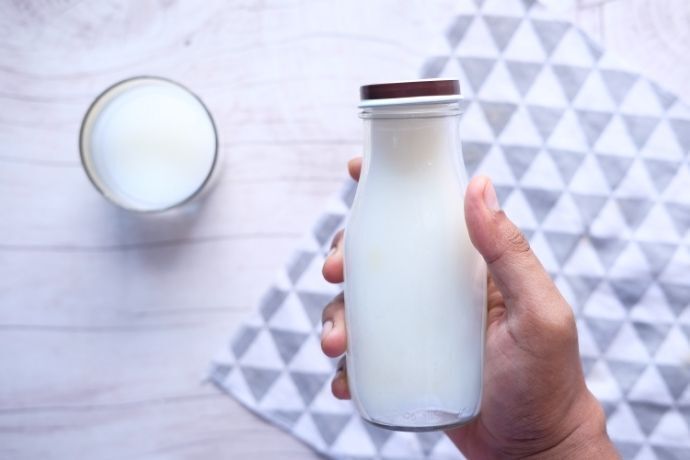
Indispensable in a balanced routine, building foods help regulate the metabolism, as they act in the formation of hormones. They also help strengthen the immune system. See more below.
What is the recommended daily amount of protein?
According to the RDA (Recommended Dietary Allowance), the ideal is to consume 0.8 g/Kg of protein per day. A healthy adult, for example, should eat around 60 to 75g of the nutrient daily.
However, this need varies greatly from person to person, since a child needs much more protein than an adult, as they are in the growth phase. The recommendation for older people is also a higher intake, to prevent the loss of muscle mass.
Excessive intake of building foods
Everything in excess can be bad for your health, and this maxim is no different for protein-building foods. Excessive protein intake can overload the kidneys and impair their functioning. When protein is abused, the body gives some signals. Check them out:
- Weight gain;
- Kidney stones;
- Swelling, due to fluid retention;
- Increased thirst;
- Constipation.
Therefore, the tip is to consume this food group in moderation, keeping an eye on the quantities eaten each day.
Lack of building foods
As with excess consumption of building foods, a lack of them can also cause health problems. Check out some of the symptoms:
- Excessive fatigue, because the body doesn't have enough energy;
- Hair loss or thinning, as hair follicles are made of protein;
- Loss of muscle mass, which leaves the individual too weak to perform physical activities, for example;
- Frequent cramps: this symptom is common in older people because they already lose muscle due to the ageing process;
- Frequent and never-ending illnesses, because the immune system can't function without proteins. It's worth remembering that antibodies are structures made up of proteins.
How to eat a high-protein diet?
It's not too difficult to maintain a protein-rich diet, as fortunately there's a huge variety of foods that contain this nutrient. Meat, eggs, fish, milk and dairy products can easily be incorporated into your menu.
Vegetarians and vegans can also enjoy a diet rich in protein, thanks to this plant-based nutrient. However, it's worth noting that some of them have what are known as high-quality proteins, which must be consumed daily. The typical Brazilian dish of rice and beans is ideal for starting this task.
Eat a balanced diet and don't forget the building foods!
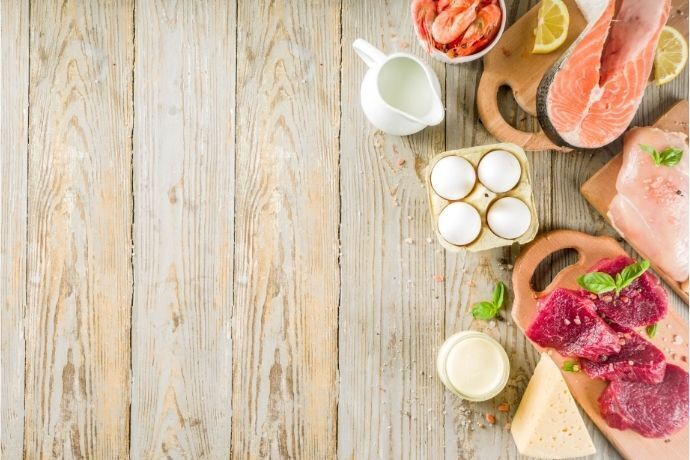
Eating a balanced diet is essential for keeping the body healthy, and a balance between the energy, regulatory and building groups is the key to preventing problems and illnesses in the short, medium and long term.
In the case of building foods, it's very important to vary and combine the two types of protein, animal and vegetable. However, if you're vegan, the tip is to alternate the different types of beans and pulses we have available. This way, you increase your intake of different nutrients and even try new flavours. Check out the protein-rich foods again in this article and prepare your listshopping!

